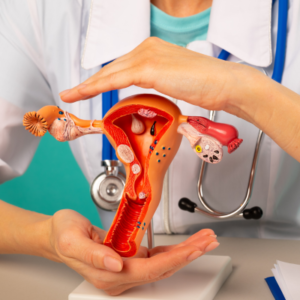 Vaginal shortening, or iatrogenic vaginal constriction, is a condition that occurs in women usually as a result of undergoing gynecological surgery. After removal or correction of organs within the pelvic area, post-surgical tweaks are always necessary to close any internal incisions, suture tissue together, and to restore the vagina back to its previous corridor-like shape.
Vaginal shortening, or iatrogenic vaginal constriction, is a condition that occurs in women usually as a result of undergoing gynecological surgery. After removal or correction of organs within the pelvic area, post-surgical tweaks are always necessary to close any internal incisions, suture tissue together, and to restore the vagina back to its previous corridor-like shape.
Depending on the extent of the surgery, sometimes it’s necessary to stitch together a great deal of a woman’s remaining tissue, leaving the vagina shorter — the same way gathering fabric to repair a hole in the toe of a sock would alter its size. Subsequent scarring in the area over time may also contribute to narrowing and reduction.
Vaginal Shortening Can Lead to Painful Sex
Vaginal tissue is extremely elastic and stretchable. However, a substantial shortening may result in uncomfortable and even painful intercourse, especially during the natural penile thrusting stage of a sexual encounter.
READ VAGINAL LENGTHENING ARTICLESWhat Causes Vaginal Shortening?
Most surgeries that involve the removal or correction of vaginal organs may contribute to this problem. Some of these procedures include:
Vaginal mesh surgery – A transvaginal surgical mesh that may have been used to repair a woman’s urinary stress incontinence or pelvic organ prolapse (POP) can cause future problems. Mesh is sometimes used to support ligaments and organs that have slipped out of place. Its purpose is to reinforce the pelvic floor or weakened vaginal wall. Sometimes the mesh can cause infection, fuse with organs and tissue, or perforate its surrounding structures, making removal necessary. Much like cement sticking to the webbing used to adhere stucco to walls in home construction projects, tissue and organs may have stuck to the transvaginal mesh, making is difficult to remove without causing damage. When this damage is extensive, additional tissue is needed to repair the vagina, thus shortening it even more.
Bladder tack surgery/bladder suspension surgery – This procedure is used to minimize or correct stress incontinence in women by creating a hammock shaped sling made of a mesh tape. The material is different from transvaginal mesh, but with similar complications. If rejection, fusion, or infection arise, the methods used to correct these post-surgical problems may result in vaginal shortening.
Anterior repair/posterior repair (colporrhaphy) – Anterior repair surgery tightens the front wall of the vagina when the bladder has drooped or fallen out of place (cystocele or dropped bladder). Posterior repair surgery tautens a rectum that has sagged or dropped (rectocele or rectal prolapse). Though both procedures are minimally invasive, complications may occur that require surgical attention and subsequent suturing, in turn shortening the vagina.
Enterocele repair – This reparation is necessary when intestines (small bowel) bulge through the weakened tissue at the top of the vagina. As with anterior or posterior repair, risks are uncommon but may occur, needing attention that might impact vaginal proportion.
Sacrospinous ligament/vault suspension – This procedure lifts the top of the vagina and holds it in place after complete vaginal prolapse. As with several of the previous surgeries mentioned here, postoperative stitches are necessary using a woman’s available tissue. This can minimize the original size of the vagina.
Hysterectomy – In a hysterectomy, all or part of the uterus is removed. In some cases, it may also be necessary to extract the ovaries, cervix and/or fallopian tubes. The more radical the procedure, the more internal trimming and stitching may be necessary. Hysterectomy is possibly one of the biggest causes of vaginal shortening.
Cervical or uterine cancer – Due to removal of cancerous organs, and scarring that can occur as a result of follow up radiation, both vaginal capacity is usually reduced.
Learn more. Download your FREE Vaginal Rejuvenation eBook
Can Vaginal Shortening Be Repaired?
Often, following surgery, the vagina may simply feel shorter due to swelling, inflammation, tenderness, bruising, and the presence of stitches. Vaginal tissue is very elastic, and though it may feel tight immediately after your operation, size often returns to normal after a short recovery time.
If actual shortening has occurred, repair can sometimes be complicated, depending on the extent of the surgery or cause of the diminishment.
Though it is possible to approach correction by using more drastic measures such as muscle flaps, biological animal grafts, skin grafts, or even a woman’s own bowel tissue, these methods can cause further complications and we prefer to avoid them.
We opt for the least physically intrusive methods first to repair vaginal shortening. Several of these options are:
Pelvic floor massage – Internal and external massage can relax tenderness, muscle tightness and trigger points that cause pain, gently stretching or tightening the pelvic floor muscles and connective tissue.
Pelvic floor physiotherapy – These exercises stretch and strengthen the pelvic floor muscles.
Vaginal dilators – Plastic tubes that gradually increase in size are inserted to gently stretch the vagina over time.
If these procedures prove to be ineffective, laparoscopic surgery, which is minimally invasive and generates less blood loss, scarring, and a quicker postoperative recovery time may be beneficial.
REQUEST MORE INFORMATIONHow Can Cherokee Women’s Health Specialists Help?
Cherokee Women’s Health Specialists is a broad-based OB/GYN practice consisting of three double board-certified urogynecologists with certification in OB/GYN and Female Pelvic Medicine and Reconstructive Surgery (FPMRS), a highly coveted credential approved only under the most stringent criteria set forth by the American Board of Medicine (ABM). Our surgeons at Cherokee Women’s Health offer a combined experience of over 35 years of performing vaginal rejuvenation procedures.
Whatever the reason for vaginal shortening, we can recommend the safest and most effective approach to try and correct the problem. To make an appointment, call us at 770.721.6060.
Vaginal Lengthening Articles

Do I Have a Shallow Vagina?

19 Reasons for a Low Sex Drive



